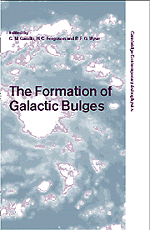Book contents
- Frontmatter
- Contents
- Preface
- Dedication: In Memory of Olin Eggen
- Part 1 Introduction
- Part 2 The Epoch of Bulge Formation
- Part 3 The Timescales of Bulge Formation
- Part 4 Physical Processes in Bulge Formation
- The Role of Bars for Secular Bulge Formation
- Bars and Boxy/Peanut-Shaped Bulges: An Observational Point of View
- Boxy- and Peanut-Shaped Bulges
- A New Class of Bulges
- The Role of Secondary Bars in Bulge Formation
- Radial Transport of Molecular Gas to the Nuclei of Spiral Galaxies
- Dynamical Evolution of Bulge Shapes
- Two-Component Stellar Systems: Phase-Space Constraints
- Central NGC 2146 – A Firehose-Type Bending Instability?
- Bulge Formation: The Role of the Multi-Phase ISM
- Global Evolution of a Self-Gravitating Multi-Phase ISM in the Central Kpc Region of Galaxies
- Part 5 Bulge Phenomenology
- Part 6 Conference Summary
- Index
Global Evolution of a Self-Gravitating Multi-Phase ISM in the Central Kpc Region of Galaxies
from Part 4 - Physical Processes in Bulge Formation
Published online by Cambridge University Press: 10 November 2010
- Frontmatter
- Contents
- Preface
- Dedication: In Memory of Olin Eggen
- Part 1 Introduction
- Part 2 The Epoch of Bulge Formation
- Part 3 The Timescales of Bulge Formation
- Part 4 Physical Processes in Bulge Formation
- The Role of Bars for Secular Bulge Formation
- Bars and Boxy/Peanut-Shaped Bulges: An Observational Point of View
- Boxy- and Peanut-Shaped Bulges
- A New Class of Bulges
- The Role of Secondary Bars in Bulge Formation
- Radial Transport of Molecular Gas to the Nuclei of Spiral Galaxies
- Dynamical Evolution of Bulge Shapes
- Two-Component Stellar Systems: Phase-Space Constraints
- Central NGC 2146 – A Firehose-Type Bending Instability?
- Bulge Formation: The Role of the Multi-Phase ISM
- Global Evolution of a Self-Gravitating Multi-Phase ISM in the Central Kpc Region of Galaxies
- Part 5 Bulge Phenomenology
- Part 6 Conference Summary
- Index
Summary
Using high resolution, two-dimensional hydrodynamical simulations, we investigate the evolution of a self-gravitating multi-phase interstellar medium in the central kiloparsec region of a galactic disk. We find that a gravitationally and thermally unstable disk evolves, in a self-stabilizing manner, into a globally quasi-stable disk that consists of cold (T < 100 K), dense clumps and filaments surrounded by hot (T > 104 K), diffuse medium. In the quasi-stable phase where cold and dense clouds are formed, the effective stability parameter, Q, has a value in the range 2-5. The dynamic range of our multi-phase calculations is 106 – 107 in both density and temperature. Phase diagrams for this turbulent medium are analyzed and discussed. We also succeeded in modeling star formation in the multi-phase ISM with 2 pc resolution. Massive stars formed in the dense, cold clouds are tracked for their life time, and finally explode as SNe. The filamentlike structure of the cold gas is stable for the SNe, although bubbles of the hot gas (T > 106 K) are formed. We observed recurrent burst-like SNe production.
Introduction
We model the multi-phase and inhomogeneous interstellar medium (ISM) in the inner region of a galactic disk including fundamental physical processes crucial for understanding star formation, global and local dynamics of the ISM in galaxies, and aspects of galaxy formation such as feedback. Most numerical simulations of the ISM and of star formation in galaxies have assumed simpler ISM models, e.g. an isothermal or nearly-isothermal equation of state, and either a smooth medium or discrete clouds.
- Type
- Chapter
- Information
- The Formation of Galactic Bulges , pp. 152 - 156Publisher: Cambridge University PressPrint publication year: 2000



